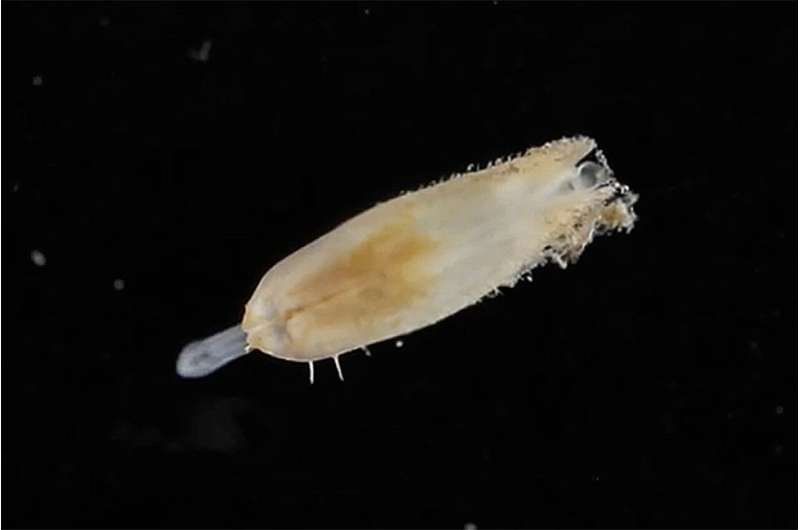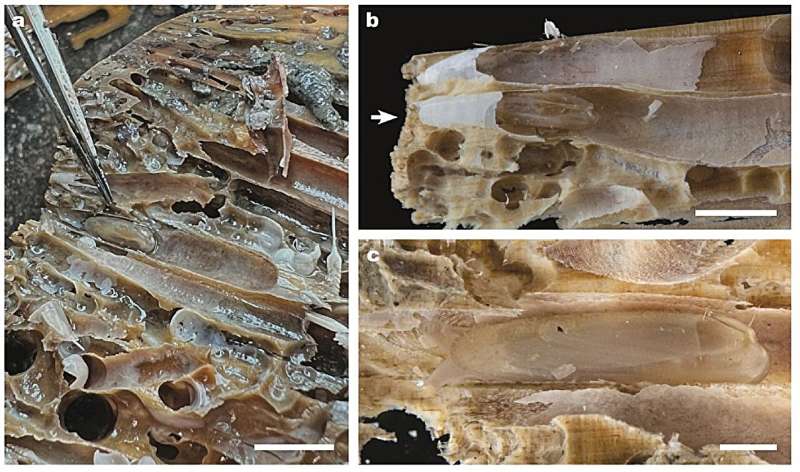This article has been reviewed according to Science X's editorial process and policies. Editors have highlighted the following attributes while ensuring the content's credibility:
fact-checked
trusted source
proofread
Researchers discover new species of mussel that lives in an ancient undersea forest

A Northeastern marine scientist has discovered a new species of tiny mollusk that lives in an ancient, submerged cypress grove called the Alabama Undersea Forest.
Dan Distel, research professor at Northeastern's Marine Science Center, says the bivalve described in the journal Deep Sea Research Part I: Oceanographic Research Papers represents a new genus and species of mussel and offers important clues about how marine life developed in some of the most fascinating environments in the ocean.
It is also the first species discovered as part of Ocean Census, a new global alliance that aims to discover 100,000 species in the next 10 years.
"This discovery is important because it helps explain mysteries involving some of the ocean's most extraordinary ecosystems—including deep-sea hydrothermal vents," Distel says.
The newly discovered mussel is called Vadumodiolus teredinicola—a long name for a creature that ranges in size from a grain of rice to a thumbnail.
"The name is a mouthful," Distel says.
It means "shallow mussel shipworm dweller" because it was found in just 18 meters of water in the Gulf of Mexico inside the burrow of a shipworm, which is known as the termite of the sea for its ability to burrow into and digest wood, including wooden ship hulls.

Distel came across the new mollusk while studying shipworms that had made their home in ancient wood from a submerged bald cypress forest known as the Alabama Undersea Forest.
The recently discovered forest—which had been covered by sea level rise tens of thousands of years ago—lies 60 feet beneath the gulf's surface, which is shallow by marine science standards.
Collected by scuba divers, "the wood was incredibly well preserved. It almost looks like fresh wood," Distel says, adding that the ancient cypress still appeals to the shipworms he has made a major focus of his study.
"One day, I was dissecting a piece of wood and out of a shipworm burrow popped this tiny little bivalve, barely the size of a grain of rice," Distel says. "I looked at that thing and I thought to myself, 'I recognize this, but I just can't place it.'"
Distel says the creature somehow crawled out of its dish and disappeared, but after a while he found another one.
"Finally, it dawned on me. I didn't recognize these guys because they belonged to a group of bivalves that are found nearly exclusively in the deep sea," he says.
"This belongs to the same group as giant mussels that are found at the deep-sea hydrothermal vents. The vent mussels can be more than a foot long."
Using genetic analysis and molecular phylogeny, "We were able to show that the new species is, in fact, related to these deep-sea mussels. But they were sufficiently different that we couldn't place them into any of the known genera or species. So, we named a new genus and a new species."
Clues to how mussels invaded hydrothermal vents
The discovery makes the tiny mollusk the first species to be found as part of the Ocean Census project to add 100,000 new species to 245,000 accepted marine species in the World Registry of Marine Species.
The Ocean Genome Legacy Center is a lead partner in the collaborative effort to fill in gaps in scientists' understanding of marine environments.
Finding and naming Vadumodiolus teredinicola helps explain how thriving animal communities evolved at deep-sea hydrothermal vents, Distel says.
"The vents are volcanic hot springs that spew toxic gases, including hydrogen sulfide and methane (natural gas). Animals living around the vents are weird because they don't eat," Distel says.
"Instead, they harbor symbiotic bacteria inside their cells that consume the toxic gases and use them to produce nutrients to feed the animal hosts. But how these strange animals got to these remote deep-sea environments and how their symbioses evolved have remained mysteries."
Distel says, "The newly discovered mussel's existence supports the idea that giant mussel species found at the deep-sea vents evolved from shallower water ancestors."
Fragile…and trapped
It could be the case that the ancestors of the little mollusks, which harbor symbiotic bacteria very similar to those found in the deep-sea mussels, sank with waterlogged wood to the ocean's deep, dark trenches and took advantage of the rich supply of the toxic gases around hydrothermal vents to grow larger, he says.
Distel says that Vadumodiolus teredinicola, which is a species of bathymodiolin mussel, has such a thin and fragile shell researchers manipulate a pair of paintbrushes like chopsticks to pick them up and move them.
The paper-thin fragility of the mollusk shell makes sense since the little mussel spends its entire life encased in the shipworm burrow, making it a good example of the symbiotic or interdependent relationships he studies in marine animals, Distel says.
"Many of the features of the mussels suggest that they are adapted for living inside of shipworm burrows," he says. "They enter the narrow burrow entrances as larvae, but they can no longer get out when they grow larger. They're trapped there forever."
Distel says he first wrote 20 years ago about the possibility that the ancestors of the hydrothermal vent mussels lived in shallower water but over time rode sunken tree trunks and limbs stepwise to deeper and deeper depths, a theory he called "the wooden steps hypothesis."
"I think the take-home message is that this symbiosis became established in the shallow water ancestor of both our new discovery and the deep-sea guys. And the symbiosis allowed these animals to associate with woods and then allowed them to follow wood getting transported huge distances across the world, across entire ocean basins," he says.
"Eventually, wood gets waterlogged and sinks to the bottom. So, it's interesting how this symbiotic relationship, which became established more than 100 million years ago, led to a chain of events that allowed these organisms to invade both deep and shallow water environments."
More information: Marvin A. Altamia et al, Wooden steps to shallow depths: A new bathymodiolin mussel, Vadumodiolus teredinicola, inhabits shipworm burrows in an ancient submarine forest, Deep Sea Research Part I: Oceanographic Research Papers (2024). DOI: 10.1016/j.dsr.2023.104220
Provided by Northeastern University
This story is republished courtesy of Northeastern Global News news.northeastern.edu.





















